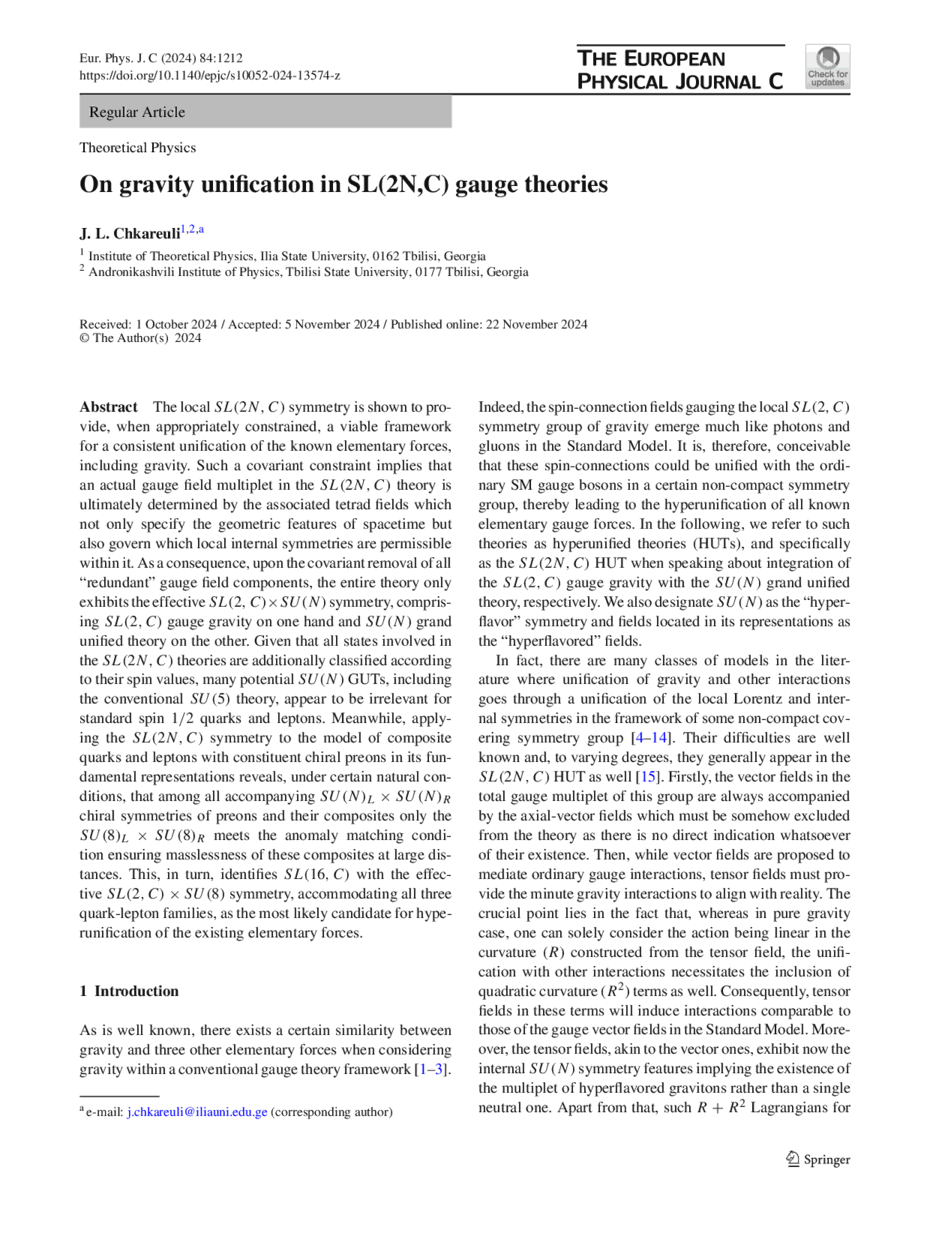https://doi.org/10.1140/epjc/s10052-024-13574-z
Regular Article
On gravity unification in SL(2N,C) gauge theories
1
Institute of Theoretical Physics, Ilia State University, 0162, Tbilisi, Georgia
2
Andronikashvili Institute of Physics, Tbilisi State University, 0177, Tbilisi, Georgia
Received:
1
October
2024
Accepted:
5
November
2024
Published online:
22
November
2024
The local SL(2N, C) symmetry is shown to provide, when appropriately constrained, a viable framework for a consistent unification of the known elementary forces, including gravity. Such a covariant constraint implies that an actual gauge field multiplet in the SL(2N, C) theory is ultimately determined by the associated tetrad fields which not only specify the geometric features of spacetime but also govern which local internal symmetries are permissible within it. As a consequence, upon the covariant removal of all “redundant” gauge field components, the entire theory only exhibits the effective  symmetry, comprising SL(2, C) gauge gravity on one hand and SU(N) grand unified theory on the other. Given that all states involved in the SL(2N, C) theories are additionally classified according to their spin values, many potential SU(N) GUTs, including the conventional SU(5) theory, appear to be irrelevant for standard spin 1/2 quarks and leptons. Meanwhile, applying the SL(2N, C) symmetry to the model of composite quarks and leptons with constituent chiral preons in its fundamental representations reveals, under certain natural conditions, that among all accompanying
symmetry, comprising SL(2, C) gauge gravity on one hand and SU(N) grand unified theory on the other. Given that all states involved in the SL(2N, C) theories are additionally classified according to their spin values, many potential SU(N) GUTs, including the conventional SU(5) theory, appear to be irrelevant for standard spin 1/2 quarks and leptons. Meanwhile, applying the SL(2N, C) symmetry to the model of composite quarks and leptons with constituent chiral preons in its fundamental representations reveals, under certain natural conditions, that among all accompanying  chiral symmetries of preons and their composites only the
chiral symmetries of preons and their composites only the  meets the anomaly matching condition ensuring masslessness of these composites at large distances. This, in turn, identifies SL(16, C) with the effective
meets the anomaly matching condition ensuring masslessness of these composites at large distances. This, in turn, identifies SL(16, C) with the effective  symmetry, accommodating all three quark-lepton families, as the most likely candidate for hyperunification of the existing elementary forces.
symmetry, accommodating all three quark-lepton families, as the most likely candidate for hyperunification of the existing elementary forces.
© The Author(s) 2024
 Open Access This article is licensed under a Creative Commons Attribution 4.0 International License, which permits use, sharing, adaptation, distribution and reproduction in any medium or format, as long as you give appropriate credit to the original author(s) and the source, provide a link to the Creative Commons licence, and indicate if changes were made. The images or other third party material in this article are included in the article’s Creative Commons licence, unless indicated otherwise in a credit line to the material. If material is not included in the article’s Creative Commons licence and your intended use is not permitted by statutory regulation or exceeds the permitted use, you will need to obtain permission directly from the copyright holder. To view a copy of this licence, visit http://creativecommons.org/licenses/by/4.0/.
Open Access This article is licensed under a Creative Commons Attribution 4.0 International License, which permits use, sharing, adaptation, distribution and reproduction in any medium or format, as long as you give appropriate credit to the original author(s) and the source, provide a link to the Creative Commons licence, and indicate if changes were made. The images or other third party material in this article are included in the article’s Creative Commons licence, unless indicated otherwise in a credit line to the material. If material is not included in the article’s Creative Commons licence and your intended use is not permitted by statutory regulation or exceeds the permitted use, you will need to obtain permission directly from the copyright holder. To view a copy of this licence, visit http://creativecommons.org/licenses/by/4.0/.
Funded by SCOAP3.





